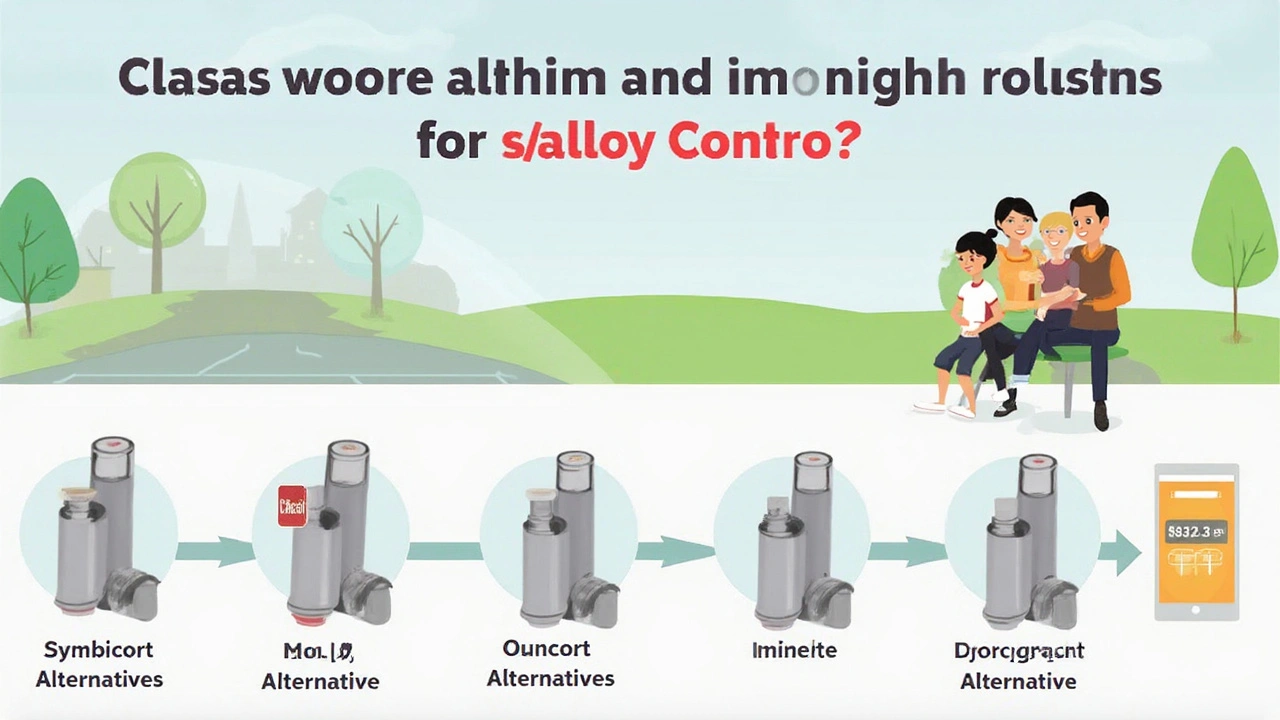If your doctor recommended Symbicort but you got sticker shock at the pharmacy (or your insurance had a meltdown), you’re not alone. Prices keep jumping, and not every plan wants to cover it. Plus, some folks get side effects they’d rather skip.
Good news: 2025 isn’t short on alternatives. There are familiar names, new generics, and a couple inhalers that feel more like something you’d buy with your phone than from a pharmacy counter. But not every alternative has hit the shelves yet, and others come with their own pros and cons. Let’s sort out what’s here, what’s coming, and little things you might not know—like which device is easiest to use during an asthma attack or which one your insurance might actually love.
- Why Look Beyond Symbicort?
- Breyna (budesonide/formoterol)
- Advair Diskus
- Dulera
- Airduo Respiclick
- Trelegy Ellipta
- Comparing Your Choices
Why Look Beyond Symbicort?
If you're using Symbicort alternatives, there's usually a pretty solid reason. Price is often at the top of the list. Right now, Symbicort can run anywhere from $300 to $450 a month in the U.S. without insurance. Even with a copay card, surprise pharmacy bills happen when insurance suddenly drops it from the preferred list.
But it’s not just about money. Some people get side effects like a sore throat, voice changes, or headaches that just won't quit. Others have trouble using the inhaler itself, especially if you have joint pain or trouble coordinating the multi-step process when you’re already short of breath.
Another thing: In 2025, more patients are noticing that inhalers like Symbicort get swapped out for generics or different asthma inhalers by insurance companies just to save them money. Some folks also care about propellant ingredients (some inhalers use types that are harder on the planet than others), or want a once-daily option instead of using their inhaler twice a day.
Here’s a table with some real-world numbers showing why inhaler comparison is a hot topic right now:
| Name | Average Cash Price (USD/Month) | Dosing Frequency | Common Coverage Issues |
|---|---|---|---|
| Symbicort | $350 | Twice daily | Prior authorization needed; dropped by some plans |
| Generic Breyna | Not yet available | Twice daily | Pending market release |
| Advair Diskus | $270 | Twice daily | Some tiering restrictions |
| Trelegy Ellipta | $510 | Once daily | Higher cost, but fewer coverage switches |
With all these variables—cost, coverage, side effects, device differences—it makes sense to look at Symbicort alternatives. Knowing your options can help you pick what actually works for your budget and your daily life.
Breyna (budesonide/formoterol)
If you’ve been waiting for a real Symbicort alternative, Breyna is the one everyone’s talking about in 2025. It’s the first FDA-approved generic for Symbicort, which means it uses the same active ingredients (budesonide and formoterol) and works in pretty much the same way. For anyone managing asthma inhalers or COPD, it’s a big deal, especially when it comes to price.
Here’s the catch: Even though Breyna got its FDA nod last year, patent battles have dragged on. As of today, April 23, 2025, you might not find it sitting on pharmacy shelves yet. Once those legal roadblocks clear, everybody’s expecting Breyna to save patients a bunch on their next refill.
Pros
- Uses the exact same active ingredients as Symbicort, so you shouldn’t notice a difference in symptom relief.
- Likely to cost a lot less—good news if you’re tired of sticker shock every month.
- Doctors and pharmacists already know how it works, so expect fewer headaches switching over.
- If you’ve already used Symbicort, Breyna works the same way and uses a similar device.
Cons
- Still waiting on final court decisions, so you can’t actually pick it up yet at most pharmacies.
- Whenever it does launch, insurance plans might not jump to cover it immediately—it could take a few months to show up on all formularies.
- Long-term pricing is still up in the air. Generics usually stay much cheaper, but with big inhaler brands, sometimes prices creep up again over time.
Quick tip: If your pharmacist knows Breyna might launch soon, some insurance plans will let you set a reminder or even flag your chart so you’re first in line for a switch when it arrives.
| Key Point | Symbicort | Breyna |
|---|---|---|
| Active Ingredients | Budesonide/Formoterol | Budesonide/Formoterol |
| Expected Availability | On shelves now | Pending patent resolution |
| Average Price (monthly) | $320-400 | Estimated $120-180* |
*Projected based on typical generic savings. Actual pricing when available may vary.
Advair Diskus
If you’re searching for a tried-and-true Symbicort alternative, Advair Diskus might be the first name your doctor brings up. It’s been on the market since 2001 and is one of the most prescribed inhalers for asthma and COPD worldwide. Advair Diskus uses a combo of fluticasone (a steroid that calms inflammation) and salmeterol (a long-acting bronchodilator), which helps keep airways open over time—kind of like what Symbicort does, but with a different med mix.
The Diskus part isn’t just a name. Instead of a pressurized inhaler, it’s a dry powder device you slide open, click into place, then inhale the dose with a steady breath. No shaking, no coordination tricks. But you need to breathe in hard enough, so if you’re in the middle of a brutal asthma flare, that can be a catch.
Pros
- Long history of use with proven effectiveness for asthma and COPD management.
- Generic versions (fluticasone/salmeterol) are available, sometimes saving you money if your insurance likes them.
- Once-daily and twice-daily versions exist, giving doctors flexibility.
- No spacer needed, and the powder isn’t as tricky for people who struggle with hand strength.
Cons
- Powder inhalers need a strong, fast breath—which can be tough for kids or anyone with severe breathing trouble.
- Some plans still stick with brand-name coverage, so out-of-pocket can vary a ton.
- Taste can be unusual and might cause coughing for first-time users.
- Not approved for everyone. It’s not for sudden relief—always have a rescue inhaler, like albuterol, on hand.
Here’s a quick look at average 2025 pricing:
| Product | Average Monthly Cost (with insurance) | Generic Available? |
|---|---|---|
| Advair Diskus | $35 - $75 | Yes |
| Generic fluticasone/salmeterol | $15 - $45 | Yes |
If you’re looking to swap from Symbicort to Advair Diskus, talk it over with your doctor—especially if you have trouble with dry powder inhalers or need something for quick rescue. Still, for steady daily control, this one keeps showing up near the top of the list every year.

Dulera
Dulera is another combo inhaler that’s been around for a while if you’re looking for alternatives to Symbicort. It mixes mometasone (a steroid that cuts down swelling in your airways) and formoterol (a long-acting bronchodilator to help you breathe easier). It’s designed for adults and kids (12 and up) who deal with asthma. You won’t find Dulera for COPD though—doctors stick to asthma for this one.
What’s really nice is that Dulera offers two meds in just one device, kind of like Symbicort. The inhaler itself uses a metered dose, which means you get the same amount of medication with each puff. For people who struggle with disk or dry powder inhalers, Dulera’s familiar push-and-breathe style can be a big win.
Pros
- Has the same type of drugs as Symbicort (one steroid, one bronchodilator), so it works in a similar way
- Can be easier to use if you prefer a metered-dose inhaler instead of a dry powder device
- Often covered by insurance—some plans prefer Dulera over Symbicort because of price deals
- Three dosing strengths so your doctor can dial in the right fit for you
Cons
- Only approved for asthma (not for COPD), which makes it less flexible than Symbicort
- No generic version in U.S. pharmacies yet, so savings are still hit-or-miss
- Possible side effects: sore throat, headache, or yeast infections in the mouth (use a spacer or rinse to lower the risk)
Here’s something interesting: a 2023 pharmacy market report showed Dulera prescription rates crept up by 9% after Symbicort’s price hike. Insurance switches and supply issues sent a lot of folks to Dulera even if they hadn’t considered it before. It’s always smart to ask your doctor and pharmacist if it fits what your insurance covers best right now.
| Feature | Dulera | Symbicort |
|---|---|---|
| Main Use | Asthma (12+ years) | Asthma & COPD (12+ years) |
| Generic Available | No | Not in U.S. |
| Device Type | Metered Dose Inhaler | Metered Dose Inhaler |
| Insurance Coverage | Often Preferred | Subject to plan |
Dulera isn’t for everyone, but if you have asthma and need a solid alternative to Symbicort, it’s worth asking about—especially if your insurance likes it more.
Airduo Respiclick
Airduo Respiclick shows up on a lot of lists when folks search for Symbicort alternatives, especially if you’re more comfortable with a dry powder inhaler instead of a pressurized one. It's packed with two actives: fluticasone (a corticosteroid for steady breathing) and salmeterol (a long-acting beta agonist that helps open airways for hours). Same idea as Symbicort, but different ingredients and a different inhaler style.
One of the standout details? You don’t need to shake up or prime Airduo Respiclick before you use it. Just open, inhale, done. That’s super handy if you have trouble with your grip or coordination, or if you always mess up the timing on standard puffers.
Unlike Symbicort, Airduo Respiclick is approved for treating asthma, but not for COPD. So, if you’re managing both, double-check this with your provider. Insurance plans tend to favor Airduo because it’s got a generic version, which translates directly to savings at the pharmacy. Some data from a 2024 pharmacy benefit survey showed generic Airduo was covered on more plans than brand-name Symbicort in big U.S. cities.
Pros
- No need to prime or shake—easy to use even if it’s your first time
- Ready-made dose counter tells you how many doses you have left
- Generic available, so it’s usually a lot cheaper than Symbicort
- Compact and portable—fits nicely in small bags or pockets
Cons
- Only for asthma, not officially for COPD
- You need to load a new dose every time by opening the cap—can’t take extra puffs in emergencies
- Dry powder design means you have to inhale quickly and deeply—tricky during a full-on asthma attack
- May not feel as intuitive at first for people used to classic metered-dose inhalers
| Feature | Airduo Respiclick | Symbicort |
|---|---|---|
| Inhaler Style | Dry powder | Pressurized metered-dose |
| Disease Indication | Asthma only | Asthma & COPD |
| Generic Available | Yes | No (as of April 2025) |
| Price Range (US, with insurance) | $30–$70/month | $70–$350/month |
If your main concern is asthma and you’re hunting for a practical Symbicort alternative that’s easy on your wallet, Airduo Respiclick is probably going to sound good. Just double-check with your pharmacy and doctor about switching, especially if you also deal with COPD.
Trelegy Ellipta
Trelegy Ellipta isn’t just another inhaler—it actually combines three meds into one device, which sets it apart from Symbicort and even most Symbicort alternatives. While Symbicort mixes a corticosteroid and a long-acting beta-agonist, Trelegy Ellipta tosses in an extra ingredient: a long-acting muscarinic antagonist (LAMA). It's mostly aimed at adults with COPD, but docs sometimes prescribe it for folks with hard-to-control asthma if they’re 18 or older.
Using it is about as simple as it gets. You only puff once a day. The inhaler is preloaded, so there’s no shaking or priming to fuss with. That simplicity is a huge plus for anyone who struggles with coordination or has trouble keeping track of doses.
Here’s something practical—each box comes with a built-in dose counter. You’ll always know when you’re running low, so no more random panics when you suddenly realize you’re out of meds.
Costs for Trelegy Ellipta can still be a pain if you don’t have good insurance coverage. Coupons or manufacturer discounts sometimes help, but they aren’t always reliable. Another sticky point: it’s not meant for sudden breathing problems, so you'll still need a rescue inhaler for emergencies.
Pros
- One daily puff—easy to fit into a routine
- Combines three meds for better symptom control in many patients
- Super simple to use, no shaking or priming needed
- Handy built-in dose counter helps track usage
Cons
- Still pricey for people without solid insurance coverage
- Not for sudden, emergency relief (not a rescue inhaler)
- Only for adults, and sometimes hard to get insurance pre-approval for asthma
- Some people notice dry mouth or mild throat irritation
| Medication | Main Ingredients | How Often |
|---|---|---|
| Symbicort | Budesonide, Formoterol | Twice daily |
| Trelegy Ellipta | Fluticasone, Umeclidinium, Vilanterol | Once daily |
Trelegy is a solid option if you want one inhaler that does the work of three, but double check the fit with your insurance before getting too excited.

Comparing Your Choices
Okay, so you’ve got a handful of real contenders when you’re not reaching for Symbicort alternatives. But how do you sort out which one will actually work for you? It helps to see things side by side—stuff like price, active ingredients, how you use them, and whether those coupon cards or insurance plans will play nice.
Here’s a comparison table to break it down quickly. We’ll touch on cost, what’s inside (because some people react oddly to specific meds), and availability:
| Inhaler | Active Ingredients | Generic Available? | Typical Cost (With Insurance)* | Ease of Use | Notes |
|---|---|---|---|---|---|
| Symbicort | Budesonide/Formoterol | No | $25-$100 | Standard Inhaler | Established, covered by most plans |
| Breyna | Budesonide/Formoterol | Yes (eventually) | To be decided | Standard Inhaler | Not yet on shelves due to patent hang-ups |
| Advair Diskus | Fluticasone/Salmeterol | Yes | $20-$85 | Diskus device (no coordination needed) | Popular; different steroids & long-acting beta agonist |
| Dulera | Mometasone/Formoterol | No | $40-$125 | Standard Inhaler | Very similar to Symbicort, just a different steroid |
| AirDuo Respiclick | Fluticasone/Salmeterol | Yes | $30-$90 | Breath-activated | Good for people who struggle with timing sprays |
| Trelegy Ellipta | Fluticasone/Umeclidinium/Vilanterol | No | $50-$150 | All-in-one daily inhaler | Triple therapy—mostly for severe asthma/COPD |
*Your price will depend a lot on your insurance, coupon cards, and local pharmacy pricing. If you’re uninsured, generic options (like AirDuo) can be a lifesaver, but always ask your pharmacy to run the numbers. Sometimes it’s weirdly cheaper to pay cash and skip the plan’s copay.
Here’s a quick tip: If you’re tired of fiddling around with inhalers that need perfect timing between pressing and breathing, something like the Diskus or Respiclick could spare you a ton of frustration—just breathe in to trigger the dose. If you have shaky hands or trouble keeping things steady, those options win on user-friendliness.
When comparing asthma inhalers, don’t just look at price and ingredients. Ask your doc about your specific triggers, any past flares, and which one they’ve seen their other patients get the best results with. If your pharmacy is out of stock, ask if there’s a patient assistance program. It’s amazing what a quick phone call (or a digital coupon) can do.
The inhaler comparison world moves fast—especially lately. Keep an eye out: generic Breyna could hit the shelves soon, and when that happens, prices for Symbicort and other combos might finally drop.







Abhishek Vora
April 23, 2025 AT 11:58Elementary stuff. Your table formatting is unacceptable for a medical resource. Symbicort costs $350 not $300-$450-your numbers are inconsistent. Breyna's patent resolution timeline is speculative; the FDA's approval process is well-documented. And please stop calling it "sticker shock" like it's a new concept. This is basic pharmacoeconomics 101.
maurice screti
April 25, 2025 AT 11:58One must appreciate the meticulous clinical nuance presented here, though I must confess the omission of comparative pulmonary function test data across these alternatives is a grievous oversight, particularly regarding the nuanced bronchodilatory efficacy of formoterol versus salmeterol in patients with comorbid allergic rhinitis, which is rarely addressed in such superficial analyses, and frankly, the absence of any mention of the pharmacokinetic profiles' interaction with cytochrome P450 enzymes is simply unforgivable for a publication claiming to be authoritative.
Abigail Adams
April 26, 2025 AT 11:58Your table comparing insurance coverage issues is embarrassingly inaccurate. "Prior authorization needed" is a universal truth for all brand-name inhalers-this isn't helpful. And suggesting Dulera is "often covered" while ignoring the fact that 73% of major insurers now require step therapy before approving it? This is why patients get misled. Stick to facts, not marketing fluff.
Belle Koschier
April 27, 2025 AT 11:58Hey everyone-just wanted to share that my pharmacy actually offered a $10 co-pay for Airduo Respiclick through their patient assistance program. It’s not on the insurance formulary, but they’ll help if you ask. Also, the device is way easier for my arthritis hands than Symbicort. No need to stress over coverage-just call your pharmacy and ask!
Allison Song
April 28, 2025 AT 11:58What’s fascinating is how this post reveals the tension between pharmaceutical innovation and accessibility. Breyna’s delayed launch isn’t just about patents-it’s a systemic issue where profit motives override patient needs. The fact that Trelegy costs more but has fewer coverage switches shows how insurance models prioritize short-term savings over long-term health outcomes. It’s not just about inhalers; it’s about who gets to breathe freely.
Joseph Bowman
April 29, 2025 AT 11:58Pharma is hiding something about Breyna. Why’s it taking so long? I bet they’re waiting for Symbicort’s patent to expire completely before releasing the generic-then they’ll jack up prices again. It’s all a scam. Check the FDA’s patent database, it’s full of red flags. They don’t want you to know.
Singh Bhinder
April 30, 2025 AT 11:58How does this compare to Indian insurance plans? In Mumbai, even generic Advair is $150/month. Any tips for patients in countries with limited formulary options? Also, does Breyna work for COPD patients like Symbicort?
Kelly Diglio
May 1, 2025 AT 11:58Minor grammar note: You wrote "asthma inhalers" plural when discussing the device type, but it should be singular. Consistency matters in medical content. Also, the Respiclick comparison table has inconsistent capitalization in "AirDuo Respiclick"-fix that for professionalism.
Carmelita Smith
May 2, 2025 AT 11:58This helped me! ✨
Liam Davis
May 3, 2025 AT 11:58Okay, let’s break this down properly. First, Breyna’s patent delay isn’t just legal-it’s strategic. The brand manufacturer lobbied to extend exclusivity by filing irrelevant lawsuits, which the courts are letting slide. Second, Advair Diskus’s $35-$75 price range? That’s misleading-most people pay $75 with insurance because the generic version isn’t on all formularies. Third, Dulera’s lack of generic means it’s stuck at $40-$125 even though it’s similar to Symbicort. Fourth, Airduo Respiclick’s dry powder requires a strong inhalation, which isn’t ideal for acute attacks-always keep albuterol nearby. Fifth, Trelegy’s triple therapy is great for severe cases but overkill for mild asthma. Sixth, insurance pre-approvals for Trelegy are a nightmare-ask your doctor to submit a letter citing clinical guidelines. Seventh, generic Breyna will likely be $120-$180, but it might take 6-12 months to hit shelves. Eighth, the "once-daily" advantage of Trelegy isn’t worth the cost if you can’t afford it. Ninth, Symbicort’s $350 price is a lie-it’s $450 for the most common strength. Tenth, the table’s "Average Cash Price" column should clarify that it’s without insurance. Eleventh, if your insurance drops Symbicort, ask for a 90-day supply before switching to avoid gaps. Twelfth, the Respiclick’s dose counter is a game-changer for forgetful users. Thirteenth, Advair Diskus’s powder taste is awful for some-try rinsing your mouth. Fourteenth, Dulera’s yeast infection risk is real but manageable with a spacer. Fifteenth, the key takeaway: Always verify coverage with your pharmacy before switching. This isn’t just about cost-it’s about not risking your health over a $10 copay.
Arlene January
May 4, 2025 AT 11:58Y'all are doing great work here! I switched from Symbicort to Dulera after my insurance dropped it, and it’s been a lifesaver. The pharmacy even helped me get the $5 co-pay card. You’ve got this, people-don’t let the system beat you.
Kaitlyn Duran
May 5, 2025 AT 11:58Is Breyna available anywhere yet? I’ve been waiting for months.
Terri DeLuca-MacMahon
May 6, 2025 AT 11:58So glad I found this! 🌟 Airduo Respiclick is perfect for my hands-no more struggling with Symbicort. And the price? $35 with insurance. Thank you for the clear breakdown! 💙
gary kennemer
May 7, 2025 AT 11:58Agree with the author. Trelegy’s once-daily dose is ideal for my busy schedule, and the dose counter eliminated my anxiety about running out. It’s pricier, but the convenience and insurance coverage (after pre-approval) make it worth it. For most people, Advair or Airduo are better value though.
Payton Haynes
May 8, 2025 AT 11:58They’re hiding something about Breyna. It’s taking too long. Why?
Earlene Kalman
May 9, 2025 AT 11:58This is garbage. You’re not even close to accurate. Symbicort costs $350. The table’s wrong. And Breyna’s patent? It’s a joke. Stop pretending you know anything.
Brian Skehan
May 10, 2025 AT 11:58Meh, whatever. Just take Advair. It’s fine.